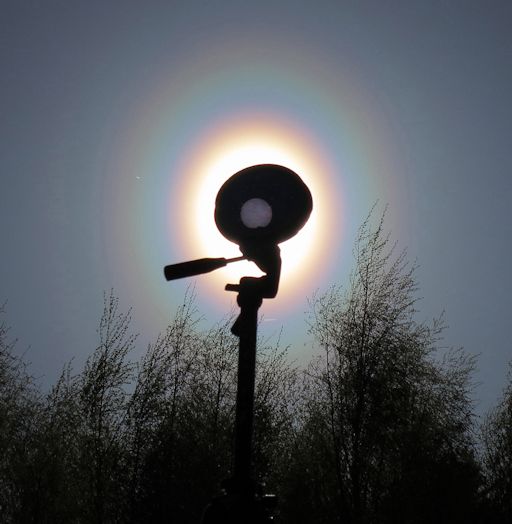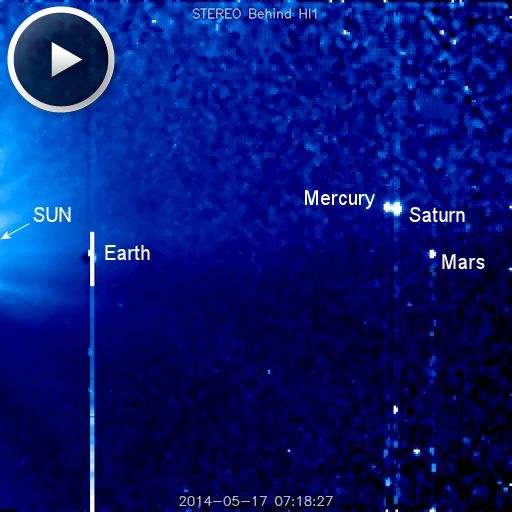Did you miss the lunar eclipse? No problem. The Coca-Cola Science Center recorded it for you. Click here to play the movie. | | |
METEOR SHOWER ALERT: Next weekend, Earth will pass through a stream of debris from Comet 209P/LINEAR. The encounter could spark a new meteor shower. Forecasters aren't sure how many meteors will appear; anything is possible from a complete dud to a magnificent meteor storm. Best estimates fall between 30 and 200 meteors per hour on May 24th between 0600 UT and 0800 UT on May 24th. Get the full story from Science@NASA. Meteor alerts: text, voice
POLLEN CORONAS: It begins with a sneeze. Pollen floating through the air tickles your nose, and your body responds by expelling the allergen. Gesundheit!
That's German for "look at the sun." Not really, but look anyway. The same pollen that makes you sneeze can also make beautiful coronas around the sun, like this one photographed May 17th by Vesa Vauhkonen of Rautalampi, Finland:

"The birch is strongly flowering now in Finland," says Vauhkonen. "This weekend we have seen soom very impressive pollen halos around the Sun."
Coronas appear when small particles scatter waves of light from the sun. Usually the particles are tiny droplets of water or ice crystals in high clouds. During northern spring, however, abundant grains of pollen can do the job, too.
"Unlike water droplets, pollens are non-spherical--and this adds to their magic," says atmospheric optics expert Les Cowley. "Many have air sacs to help carry them in the wind. These align the grains to give beautiful elliptical coronas with bright spots." This is why Vauhkonen's pollen corona looks egg-shaped instead of circular
So, the next time you sneeze... Gesundheit! ...look for coronas near the sun.
Realtime Space Weather Photo Gallery
FARSIDE PLANETARY CONJUNCTION: Mercury and Saturn are in conjunction in the night sky. Just one problem: You have to be on the far side of the sun to see it. NASA's STEREO-B probe is perfectly positioned to observe the convergence:

On Saturday, May 17th, the distance between the two planets was so narrow that they became nearly indistinguishable. If this event were visible from our side of the sun, it would surely be headline news.
NASA's STEREO probes see many things that we cannot. From their orbits high above the farside of the sun, they track hidden sunspots, anti-Earth-directed solar flares, and interplanetary CMEs. STEREO's wide-field Heliospheric Imagers also have a unique view of the planets. See above. This weekend's conjunction of Mercury and Saturn is bracketed by Mars and Earth itself, an arrangement impossible to observe from terra firma.
Realtime Space Weather Photo Gallery
Realtime Aurora Photo Gallery
Realtime Mars Photo Gallery
Realtime Comet Photo Gallery
Every night, a network of NASA all-sky cameras scans the skies above the United States for meteoritic fireballs. Automated software maintained by NASA's Meteoroid Environment Office calculates their orbits, velocity, penetration depth in Earth's atmosphere and many other characteristics. Daily results are presented here on Spaceweather.com.
On May. 17, 2014, the network reported 13 fireballs.
(12 sporadics, 1 eta Aquariid)

In this diagram of the inner solar system, all of the fireball orbits intersect at a single point--Earth. The orbits are color-coded by velocity, from slow (red) to fast (blue). [Larger image] [movies]
Potentially Hazardous Asteroids (
PHAs) are space rocks larger than approximately 100m that can come closer to Earth than 0.05 AU. None of the known PHAs is on a collision course with our planet, although astronomers are finding
new ones all the time.
On May 18, 2014 there were potentially hazardous asteroids.
Notes: LD means "Lunar Distance." 1 LD = 384,401 km, the distance between Earth and the Moon. 1 LD also equals 0.00256 AU. MAG is the visual magnitude of the asteroid on the date of closest approach. | | The official U.S. government space weather bureau |
| | The first place to look for information about sundogs, pillars, rainbows and related phenomena. |
| | Researchers call it a "Hubble for the sun." SDO is the most advanced solar observatory ever. |
| | 3D views of the sun from NASA's Solar and Terrestrial Relations Observatory |
| | Realtime and archival images of the Sun from SOHO. |
| | from the NOAA Space Environment Center |
| | the underlying science of space weather |

